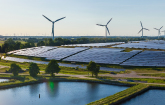Industrial Biorefineries Conventional Biorefining Status, Advanced Biorefining Technology Assessments, Policy Issues, Stakeholder Analysis, and Global Market Forecasts for New Biorefinery Construction
NEW YORK, Sept. 19, 2012 /PRNewswire/ -- Reportlinker.com announces that a new market research report is available in its catalogue:
http://www.reportlinker.com/p0972486/Industrial-Biorefineries-Conventional-Biorefining-Status-Advanced-Biorefining-Technology-Assessments-Policy-Issues-Stakeholder-Analysis-and-Global-Market-Forecasts-for-New-Biorefinery-Construction.html#utm_source=prnewswire&utm_medium=pr&utm_campaign=Renewable_energy
Conventional Biorefining Status, Advanced Biorefining Technology Assessments, Policy Issues, Stakeholder Analysis, and Global Market Forecasts for New Biorefinery Construction
As the engine behind the emerging bio-based economy, the rapidly evolving industrial biorefining sector now sits at the bottom of its next innovation cycle. With conventional ethanol and biodiesel capacity growth plateauing, a bevy of advanced conversion technologies are now being deployed in a number of first-of-kind biorefinery projects scattered throughout the world. Driven by global biofuel mandates, demand from a diversity of end-use stakeholders, and near-term revenue opportunities in chemical and product markets, these projects are the culmination of decades of research, but have yet to prove that they can be price-competitive with fossil fuels at scale.
Although emerging integrated biorefineries are capable of establishing revenue in fuel, chemical, product, and power markets, industry scale-up is closely tied to the expanding biofuels opportunity. Biofuel blending mandates in 40+ countries have carved out a $250 billion dollar market opportunity for biomass-derived fuels over the next decade. While early success in Brazil, the United States, and the European Union have proven that conventional biorefining can be competitive at scale, the industry must now demonstrate feedstock flexibility, product neutrality, and sustainability across retrofit, bolt-on, and new-build facilities if it is to capitalize on this potential.
This Pike Research report provides an in-depth analysis of global biorefinery construction for conventional and advanced biomass conversion facilities, including biochemical, physical chemical, thermochemical, and hybrid pathways. The study includes in-depth assessments of leading markets and sub-regions for the deployment of biorefineries, projected market share for emerging conversion platforms, and key industry players engaged in the market. Worldwide market forecasts – segmented by region, market, and biorefinery generation – are provided through 2022 for installed capacity by volume, annual biorefinery commissions, and capital investment in new biorefinery construction.
Key Questions Addressed:
-Which regions and key markets offer the greatest potential for biorefinery scale-up?
-How will emerging demand from oil, chemical, food and beverage, commercial, and military stakeholders impact the expansion of biorefining capacity?
-How will emerging advanced biorefinery growth compare to new conventional biorefinery expansion over the next decade?
-Which advanced conversion platforms will account for the greatest market share over the next decade?
-Which emerging integrated biorefinery business models are having the greatest impact on current projects?
-How will future biorefinery capacity compare to biofuels production mandates?
Who needs this report?
-Conventional and advanced biofuels producers
-Biomass feedstock growers and suppliers
-Engineering, procurement, and construction (EPC) companies
-Petrochemical producers
-Oil and gas refiners
-Government agencies and policy makers
-Investors and financial institutions
-Industry associations
Table of Contents
1. Executive Summary
1.1 The Dawn of Advanced Biorefining
1.2 Global Biorefinery Overview
1.3 Biorefinery Outlook
2. Market Issues
2.1 Rise of the Bio-based Economy
2.1.1 Brief History of the Bio-based Economy
2.1.2 Current State of the Bio-based Economy
2.1.3 Future of the Bio-based Economy
2.2 Role of the Biorefinery
2.2.1 Biorefinery versus the Petrorefinery
2.2.2 Current Biorefinery Status in the Global Context
2.2.2.1 Brownfield Development
2.2.2.2 Greenfield Development
2.3 Classifying Biorefineries
2.3.1 Conventional versus Advanced Biorefineries
2.3.1.1 Conventional Biorefineries
2.3.1.2 Advanced Biorefineries
2.3.2 Scaling Advanced Biorefineries
2.3.3 Other Biorefinery Classifications
2.4 Biorefinery Drivers
2.4.1 Oil Security
2.4.1.1 Dependence on Oil Imports
2.4.1.2 The Role of Strategic Partners
2.4.1.2.1. Agribusiness
2.4.1.2.2. Big Oil
2.4.1.3 Chemical and Product Multinationals
2.4.1.3.1. Commercial Aviation
2.4.1.3.2. U.S. Department of Defense
2.4.2 Economic Development
2.4.3 Refining Efficiency: The Petroleum Industry Model
2.4.4 Public Policy
2.4.4.1 Mandates
2.4.4.1.1. Biofuels Blending Mandates and Targets
2.4.4.1.2. Bio-based Chemicals and Products
2.4.4.1.3. Biopower
2.4.4.2 Subsidies and Tax Credits
2.4.4.3 Public Financing
2.4.4.4 Sustainability
2.5 Barriers to Biorefinery Deployment
2.5.1 Cost
2.5.2 Policy Uncertainty
2.5.3 Biomass Logistics
2.5.4 Technological Acceptance
2.5.5 Integration Challenges
2.5.6 Unconventional Oil and Gas
3. Key Markets
3.1 Country and Sub-regional Profiles
3.2 United States
3.2.1 Overview
3.2.2 Renewable Fuel Standard
3.3 Brazil
3.4 EU-27
3.5 China
4. Technology Issues
4.1 Biorefinery Technology Overview
4.1.1 Status of Biorefinery Platform Technologies
4.1.2 Scaling-up Advanced Biorefineries
4.2 Biorefinery Conversion Platforms
4.2.1 Biochemical Conversion
4.2.1.1 Advanced Pre-treatment Processes
4.2.1.2 Cellulosic Fermentation
4.2.1.3 Syngas Fermentation
4.2.2 Physical Chemical Conversion
4.2.3 Thermochemical Conversion
4.2.3.1 Gasification
4.2.3.2 Pyrolysis/Liquefaction
4.2.3.3 Thermal Depolymerization
4.2.4 Hybrid Pathways
4.2.5 Advanced (Non-biomass) Pathways
4.3 Advanced Biorefinery Commercialization Status
4.4 Role of the Integrated Biorefinery
4.4.1 Utilization of Existing Infrastructure
4.4.2 Component Technologies
5. Key Industry Players
5.1 Bio-based Economy Value Chain
5.2 Agribusiness
5.2.1 Archer Daniels Midland
5.2.2 Bunge
5.2.3 Cargill
5.2.4 Cosan
5.2.5 Olam International
5.3 Biofuel Refiners
5.3.1 Abengoa Bioenergia
5.3.2 Neste Oil
5.3.3 POET
5.3.4 Renewable Energy Group
5.3.5 UOP – A Honeywell Company
5.3.6 Valero
5.4 Strategic Joint Ventures
5.4.1 Butamax Advanced Biofuels
5.4.2 Diamond Green Diesel
5.4.3 DuPont Cellulosic Ethanol
5.4.4 Dynamic Fuels
5.4.5 Highlands (formerly Vercipia Biofuels)
5.4.6 INEOS New Planet BioEnergy
5.4.7 Raízen
5.5 Independent Technology Ventures
5.5.1 Amyris
5.5.2 EdeniQ
5.5.3 Elevance Renewable Sciences
5.5.4 Gevo
5.5.5 Inbicon
5.5.6 KiOR
5.5.7 LanzaTech
5.5.8 Mascoma
5.5.9 Novozymes
5.5.10 Solazyme
5.5.11 Virent
5.5.12 ZeaChem
6. Market Forecasts
6.1 Overview
6.1.1 Production Capacity Methodology
6.1.2 Biorefinery Deployments Methodology
6.1.3 Biorefinery Pathway Methodology
6.1.4 Market Value Methodology
6.2 Key Assumptions
6.3 Global Mandated Biofuels Consumption Forecasts
6.4 Global Biorefining Capacity Forecasts
6.4.1 Global Biorefining Capacity Forecasts by Generation
6.4.2 Global Biorefining Capacity Forecasts by Key Market
6.5 Global New Biorefinery Commissions Forecasts
6.5.1 Annual New Biorefinery Commissions by Region
6.5.2 Annual New Biorefinery Commissions by Generation
6.5.3 Total Biorefinery Commissions by Technology Platform
6.6 Global Biorefinery Investment Forecasts
6.6.1 Global Biorefinery Investment by Region and Key Market
6.6.2 Global Biorefinery Investment by Generation
7. Company Directory
8. Acronym and Abbreviation List
9. Table of Contents
10. Table of Charts and Figures
11. Scope of Study, Sources and Methodology, Notes
List of Charts and Figures
Market Share of Biorefineries by Region, World Markets: 2012
Green Chemical Market by Region, World Markets: 2011-2020
Projected Aviation Biofuels Demand by Region, World Markets: 2011-2021
Top 10 Oil Producers by Country, World Markets: 2011-2020
Market Share of Installed Biorefinery Capacity by Key Markets, World Markets: 2010-2012
Renewable Fuel Standard Mandates by Biofuel Segment, United States: 2009-2022
Market Share of Installed Biorefinery Capacity by Generation, World Markets: 2012
Market Share of Conventional Ethanol Biorefineries by Region, World Markets: 2012
Mandated Biofuels Consumption by Region, World Markets: 2012-2022
Estimated Annual Biorefinery Commissions by Key Markets, World Markets: 2012-2022
Biorefining Capacity by Region, World Markets: 2012-2022
Total Biorefinery Capacity by Generation, World Markets: 2012-2022
Total Biorefinery Capacity CAGR by Region and Generation, World Markets: 2012-2022
Total Biorefinery Capacity CAGR by Key Markets and Generation, World Markets: 2012-2022
Annual Biorefinery Commissions by Forecast, World Markets: 2012-2022
Annual New Biorefinery Commissions by Region, World Markets: 2012-2022
Annual New Biorefinery Commissions by Generation, World Markets: 2012-2022
Cumulative Advanced Biorefinery Commissions by Technology Platform, World Markets: 2012-2022
Cumulative Capital Investment in Biorefinery Infrastructure by Region, World Markets: 2012-2022
Cumulative Capital Investment in Biorefinery Infrastructure by Generation, World Markets: 2012-2022
List of Tables
Cumulative Capital Investment in Biorefinery Infrastructure by Generation, World Markets: 2012-2022
Average Capital Cost by Resource and Facility, World Markets: 2012
Top 15 Net Importers of Oil, World Markets: 2009
Select Biofuel Blending Mandates and Targets by Country
Biomass Power and Thermal Targets, World Markets: 2011
Average Capital Cost by Resource and Facility
Global Comparison of Average Historical Biofuels Investment versus Required Investment to Meet Mandates
Top 10 Oil Producers by Country, World Markets: 2011-2020
Market Share of Biorefineries by Region, World Markets: 2012
Green Chemical Market by Region, World Markets: 2011-2020
Aviation Biofuels Demand by Region, World Markets: 2011-2021
Market Share of Installed Biorefinery Capacity by Key Markets, World Markets: 2010-2012
Renewable Fuel Standard Mandates by Biofuel Segment, United States: 2009-2022
Market Share of Installed Biorefinery Capacity by Generation, World Markets: 2012
Market Share of Conventional Ethanol Biorefineries by Region, World Markets: 2012
Mandated Biofuels Consumption by Region, World Markets: 2012-2022
Estimated Annual Biorefinery Commissions by Key Markets, World Markets: 2012-2022
Biorefining Capacity by Region, World Markets: 2012-2022
Conventional Ethanol Biorefinery Capacity by Region, World Markets: 2012-2022
Conventional Biodiesel Biorefinery Capacity by Region, World Markets: 2012-2022
Advanced Biorefinery Capacity by Region, World Markets: 2012-2022
Total Biorefinery Capacity by Generation, World Markets: 2012-2022
Annual New Biorefinery Commissions by Region, World Markets: 2012-2022
Annual New Biorefinery Commissions by Key Market, World Markets: 2012-2022
Annual New Biorefinery Commissions by Generation, World Markets: 2012-2022
Total Biorefinery Commissions by Generation and Technology Pathway, World Markets: 2012-2022
Cumulative Capital Investment in Biorefinery Infrastructure by Region, World Markets: 2012-2022
Cumulative Capital Investment in Biorefinery Infrastructure by Key Market, World Markets: 2012-2022
To order this report:
Renewable_energy Industry: Industrial Biorefineries Conventional Biorefining Status, Advanced Biorefining Technology Assessments, Policy Issues, Stakeholder Analysis, and Global Market Forecasts for New Biorefinery Construction
Nicolas Bombourg
Reportlinker
Email: [email protected]
US: (805)652-2626
Intl: +1 805-652-2626
SOURCE Reportlinker
WANT YOUR COMPANY'S NEWS FEATURED ON PRNEWSWIRE.COM?
Newsrooms &
Influencers
Digital Media
Outlets
Journalists
Opted In




Share this article